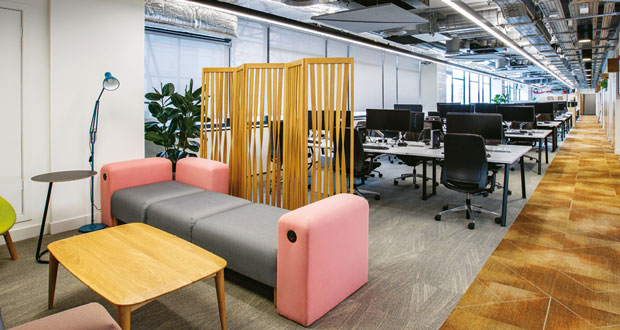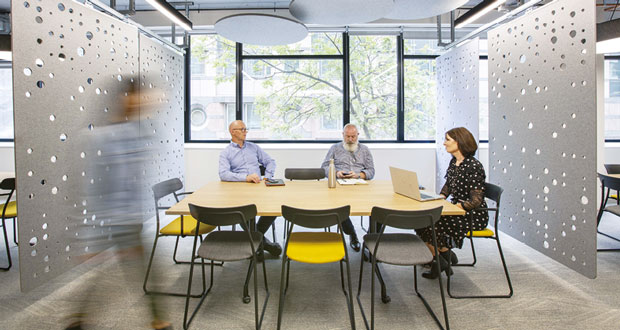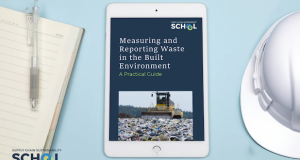EMBODIED CARBON
As the carbon which is embedded into the building during construction or fitouts, embodied carbon is not something you can easily improve or remove after a building is built. Up until recently, within the FM sphere which typically concentrates on operational carbon within the lifecycle of a building, embodied carbon has been largely overlooked.
But, as Sirsi explains: “It’s been talked about for a long time in construction and it’s only now that people are hearing about it outside the sector, suddenly it’s a big problem to solve, and we need to move faster to measure and manage it. The common-sense thing to do is use a building as much as you can before demolishing it, which is the more straightforward solution.
“The problem is it [embodied carbon] is unregulated at the moment, and construction teams, clients and designers are not required to think about it in depth.”
This is where Plan Z comes in, with a proposal in the Carbon Emissions (Buildings) Bill to introduce legislation towards mandatory reporting of carbon emissions in the built environment, along with limiting embodied carbon emissions on projects. The proposal has broad industry support, and if enacted would ensure that embodied carbon is assessed on all large projects, as part of a comprehensive whole life carbon assessment. It would also ensure that embodied carbon emissions are capped on all major construction projects – initially through limits on upfront embodied carbon, but over time expanding to cover all aspects of embodied carbon.
Sirsi welcomes this initiative as “an interesting concept and it’s fantastic that the construction industry is pushing regulation,” but she cautions, “a lot of work needs to be put in to regulated embodied carbon management, to address the retrofit challenge and improve our existing building stock.”
Something of huge importance to FMs operating older and less efficient buildings is that of stranded assets, which as Sirsi describes it, in the buildings context, happens when an asset becomes a liability, and is no longer lettable or usable due to changes in external factors, such as regulations.
She says: “This means [the building] becomes undervalued due to this change before its time. It might for example, happen to buildings because of the Minimum Energy Efficiency Standards (MEES) for example, so this is where the refurbishment agenda comes into play as you can retrofit buildings to meet new carbon reduction requirements.”
Financial incentives are another way of addressing this issue. She notes that much of industry best practice is now being pushed by investors and new non-financial disclosure regulations for the larger organisations. Within the commercial building sector, according to the RICS sustainability survey, enhancing the sustainability attributes of a building could enable landlords to command a rent premium, and for those buildings that aren’t green or sustainable these buildings could be given a ‘brown discount’ – discounted rents to compensate for not being sustainable.
Here, argues Sirsi, “the needle needs to move so all green buildings merit a standard rent and those which are not efficient are forced to go green to compete in the market. People will soon have standard sustainability requirements which buildings must meet and thus the retrofitting drive will start in earnest.”
ENERGY NEEDS
When it comes to the energy crisis, on the operational side FMs are encouraged to improve the performance of Building Management Systems (BMS) and look into adopting greener HVAC solutions such as communal heating systems and heat pumps, but again argues Sirsi, all these efforts depend on reviewing the lack of green investment in existing buildings.
“Planning a shift in fuel mix, while progressive, isn’t resolving the fundamental problems of the retrofit issue. We are creating a dependency on high energy use due to the inefficient building stock in the UK, and the regulations currently do not address the demand side of the problem sufficiently, keeping energy use high, and consequently, our electricity and heat bills rising.
“When we start reducing the energy demand we also create the long term resilience of the building stock, so that if we have less energy available to use, we can still stay just as warm because the building is insulated. This is why we need wide ranging policies that are impactful, and talk about outcomes, both long and short term.”
Another issue which has gained traction within the built environment, not least in the comments made at the Net Zero conference held by Workplace Trends in July, is that of overcoming greenwash in the sector and embracing the concept of ‘disruptive sustainability’.
As a green activist Sirsi admits that the construction industry is slow moving and making radical change is a longer process, but within FM which is on the operational side, it’s more about “making one good decision at a time”.
“Activism is a key part of the process and I’m very for it, I also think technology will make all the difference by helping people measure and reduce operational carbon. Within FM, technology disruption and PropTech is changing the way we do things and can drive small improvements which can build up quickly to result in larger overall impact.”
She’s also a huge advocate of encouraging the different parts of the built environment to work more closely together.
“Addressing climate change and pursuing sustainability requires what I call the ‘collective individual’, where we need the enlightenment of the individual for the collective to bring about systemic change.
“This should start early, for instance within our education system, but that plan is long term, and unfortunately as fun as it would be, the world isn’t being run by seven-year-olds!” I believe that the climate crisis is as great or a greater challenge as the pandemic, but because it’s not as pressing as COVID, change can be slow. Yet if the world can come together to address a pandemic, I am cautiously hopeful that it can do the same to address the climate crisis.
“We have existing frameworks such as Soft Landings which have been around forever, but are not always used to their full potential, so we need to embrace training and learn about the impact of our actions in our daily work.”
For her part, Sirsi will continue to promote sustainable design in her day job, share best practice in her CoreNet capacity and is also contributing to the sustainability sections of the upcoming BCO Guide to Fitout, an upgrade to the 2011 edition.
She concludes: “For me, it’s all about outcomes, outcomes, outcomes. We need to understand what the actual impact of our daily actions are likely to be. While we are in serious need of significant improvements in the sector, let’s embrace the incremental ones and make as much difference as possible.”






